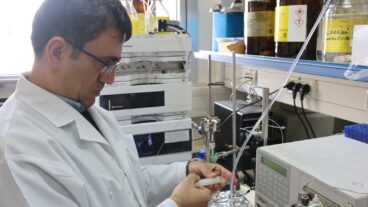Women who live in well-lit neighborhoods are more at risk from breast cancer than those who live in darker areas, according to new research by Israeli scientists.
The study, by chronobiologist Prof. Avraham Haim, doctoral student Itai Kloog, and Prof. Boris Portnov of the University of Haifa, overlaid satellite images from NASA showing how much light was emitted from neighborhoods throughout Israel, with local breast cancer statistics from Israel’s National Cancer Registry.
The researchers also carried out questionnaires on 100 women with breast cancer, and 100 healthy women on their exposure to light at night, and on a variety of socioeconomic, environmental, and genetic factors.
The researchers discovered that the rate of breast cancer in areas with average night lighting was 37 percent higher than in communities with the lowest amount of light, while the rate was a further 27% higher in areas with the highest amount of outdoor lighting.
The findings of the study, which were published in the online version of the journal Chronobiology International, support the theory that exposure to too much light at night interferes with the production of a key hormone, melatonin, raising the risk of breast cancer.
Melatonin is a powerful antioxidant that suppresses and minimizes the formation of tumors. The hormone is produced by the pineal gland in the brain, primarily at night. Levels drop dramatically in the presence of light, particularly light produced by computer screens and energy-efficient fluorescent bulbs.
This theory was first established in rats left sleeping in cages with the light on. Scientists discovered they had much higher cancer rates than those who slept in darkness. Further studies on night shift workers like nurses and flight attendants found rates of breast cancer 60 percent higher than normal. Blind women, on the other hand, who cannot detect nighttime light have been found to have lower than average rates of breast cancer than sighted women.
In December, a section of the World Health Organization announced that it recognized night-shift work as a “probable carcinogen,” as risky to workers as exposure to some toxic chemicals including polychlorinated biphenyls (PCBs).
“By no means are we saying that light at night is the only or the major risk factor for breast cancer,” Itai Kloog told The Washington Post. “But we found a clear and strong correlation that should be taken into consideration.”
Every year in the US, 200,000 women are diagnosed with breast cancer, and more than 40,000 will die of the disease, according to statistics from the National Breast Cancer Foundation. It is the second leading cause of cancer related death in women in the US.
Haim warned that the study’s findings raise questions about the increasing use of fluorescent bulbs, favored today by many for their low use of energy. These have been found to suppress melatonin production more than traditional light bulbs.
Men may be at risk too, although the study found there was no link between strong outdoor lighting and lung cancer, which is directly associated with smoking. According to The Jerusalem Post, however, there is additional unpublished evidence suggesting that men in well-lit neighborhoods are at higher risk of prostrate cancer.
“Thomas Edison’s invention of the electric light bulb was great and changed the world, but what does it do to health?” Haim said in The Jerusalem Post. “Light is not only a source of pollution, but also a carcinogen, and this should be taken into consideration.”
He added that while light pollution was not the only cause of breast cancer, further studies on the subject should be conducted.![]()
Slashdot It!![]()













